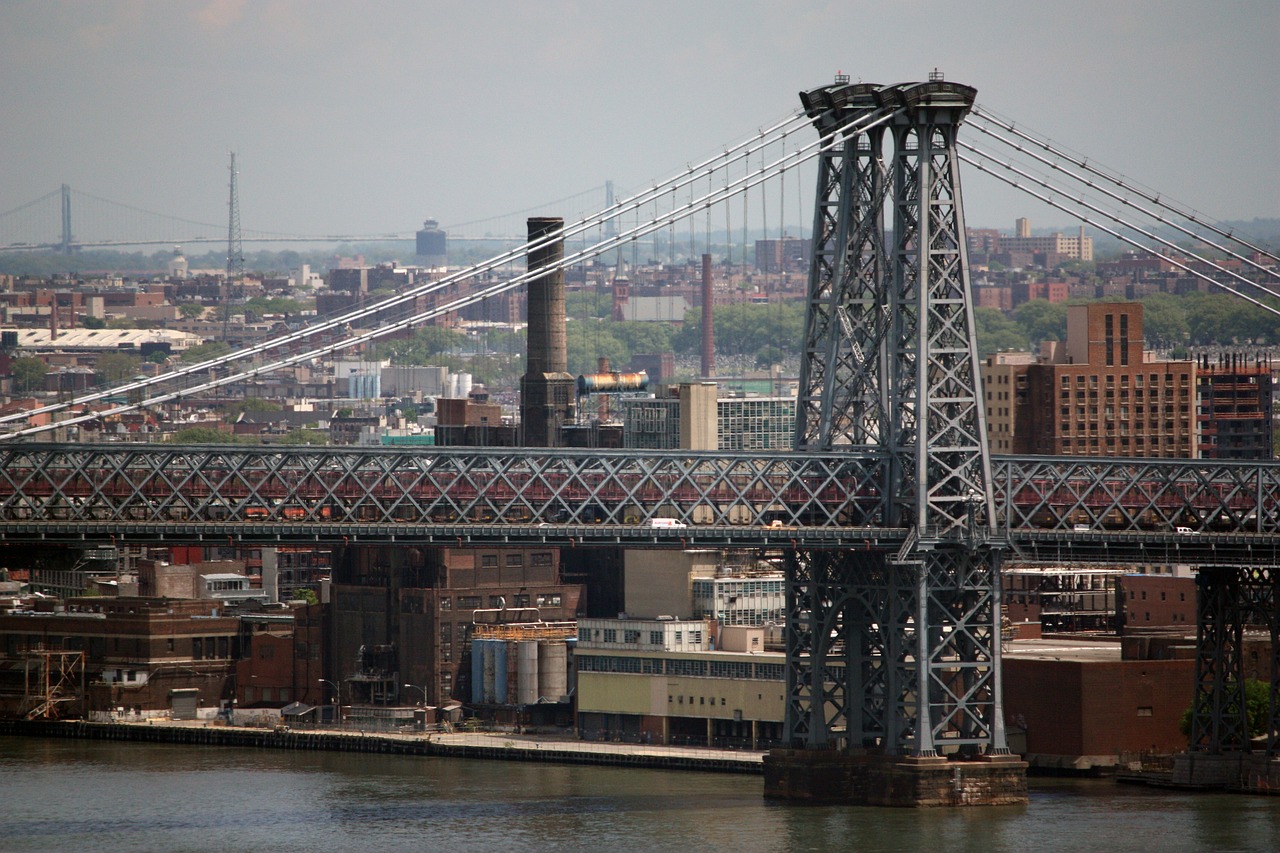W-Burg! What no hipster calls Williamsburg. Mostly it’s known as ‘The Burg”. Residents of Williamsburg love to use abbreviations.
Williamsburg is the emblem, the icon, the touchstone point for the rapid gentrification of the formerly crime-ridden New York City. It began in the nineties, when Mayor Rudy Giuliani was in full force ‘cleaning up the streets’ mode.
Now Williamsburg is a fun, upscale, artistic chic hub of New York City, the hippest neighborhood in the hippest borough, Brooklyn. It’s well-known and recognizable from popular books and movies, including ‘A Tree Grows In Brooklyn’, ‘Once Upon A Time In America’, and ‘The Sopranos’. Williamsburg stood in for Queens in ‘Coming To America’, and in ‘Daredevil’ it even stood in for Hells Kitchen in Manhattan!
Okay, so Williamsburg is diverse and painfully cool. But is it safe? Take a deep dive into Williamsburg with this article to find out the answer to this burning question!
Where Is Williamsburg?
There are five boroughs in New York City. The central borough, Manhattan, is an island. But it is just a quick hop over the river to the outer borough of Brooklyn, where Williamsburg lives.
Williamsburg is bordered by Greenpoint to the North. You will often see statistics for Williamsburg and Greenpoint bundled together, as will be referenced later in this article.
To the south, Williamsburg is bordered by another famous Brooklyn ‘hood, Bedford Stuyvesant, the setting of many of the Notorious B.I.G.’s rhymes. On the East is Bushwick, another up and coming spill over hipster neighborhood.
To the West, Williamsburg is bounded by the East River, which will take you back to Manhattan. But don’t swim! There’s plenty of public transportation, which will be covered further on in this article. Stick around!
Williamsburg requires three postal zip codes: 11211, 11206 and 11249. The postal service will be happy to assist you at either of their two branches in Williamsburg.
From Gentrification to Renaissance: How Safe is Williamsburg Today?
Originally used as fishing and hunting land by the Native American Lenape tribe, Williamsburg was first settled in the mid sixteen hundreds, when it was commonly known as Bushwick shores. Farmers would ferry their goods to Manhattan for sale.
Williamsburg was officially incorporated in the early eighteen hundreds, originally as a village within Bushwick. In 1840 Williamsburg separated from Bushwick and later was annexed into the city of Brooklyn.
For most of the nineteen hundreds, Williamsburg received influxes of immigrants, from Jews fleeing Hungary and Romania to Puerto Rico and the Dominican Republic. As industry faded, so did the fortunes of the neighborhood.
By the nineties, rents were low and artists began moving in, seeking refuge from the high rents of Manhattan. They converted factories into lofts and the neighborhood was injected with fresh air, becoming a vibrant, diverse artistic community, which, though it has matured, still remains today.
The city and the waterfront underwent a major re-zoning modification in the early 2000s and much of the industrial centers were re-zoned for residential use to accommodate the high-density overcrowding, a result of gentrification.
What To Do In Williamsburg
Plenty! Williamsburg is a collection of different sections with different vibes.
Williamsburg is not just known for the artistic culture, it has also become a hub for the music scene. The nightlife scene is very active, from legendary live music venues to live comedy shows in tiny bars.
Besides that, some of the finest chefs and cuisine in all of New York City operate in Williamsburg. On the other hand some restaurants have been there since 1887 and have earned themselves Michelin stars.
Shopping opportunities are abundant too, on Bedford Street, catering to young professionals. A slice of SoHo over the river .
Williamsburg is really experiencing a renaissance that is in full bloom.
The Who of Williamsburg
No, not the band. The people. According to the most recent data, from 2021, the head count was 134,000 and change. Including Greenpoint, the 2020 census counted 151,000. For census purposes, the neighborhood is broken into North Williamsburg and South Williamsburg.
Whites make up a large portion of the population, followed by Hispanics, which make up almost a quarter. Asian and Black are barely ten percent combined, and the rest other or mixed. Along gender lines, the population is evenly split.
The average age is 34 and over forty percent of residents fall in the 25-44 age group. Another quarter of residents are under 18. More on the family aspects of the community later.
Almost half the households speak a language other than English at home and almost a quarter of residents are foreign-born, a little higher than the citywide rate of twenty-two percent.
The median household income is over six figures and the per capita income is around sixty -two thousand dollars a year USD. About nineteen percent of the population of Williamsburg live below the poverty line, also a little higher than the citywide rate. Not the artists, I hope!
The neighborhood has definitely matured from the artist’s heyday that catapulted gentrification. Many of those artists have been compelled by higher rents to seek refuge in nearby, cheaper neighborhoods, like the now trendy Bushwick.
They have been quickly replaced by young professionals looking for somewhere cool like Manhattan without the price tag of Manhattan, but still an easy commute to Manhattan. More on the commutes a few sections down.
Williamsburg Real Estate
Where to live, of course.
Rent is expensive in Williamsburg but loads cheaper than Manhattan. Residents overwhelmingly rent their dwellings. Eighty-four percent, as opposed to sixteen percent that own their homes.
Williamsburg is desirable real estate, having ranked in the top fifty neighborhoods to live in New York City, and top forty for young professionals. Rent has more than doubled from 2006 to 2021 and rent increases are outpacing increases in household income by seventeen percent.
Apartments for rent start at a median rate of two thousand five hundred dollars a month USD. Median home values exceed one million dollars USD. Apartments can be small, but there’s lots of storage units available in the area.
Knowing Your Neighbors
The upside is you might end up next door to a celebrity! Many cool, hip famous people came up in or live now in Williamsburg. To list just a few: Winona Ryder from ‘Stranger Things’, Gene Simmons of Kiss, Peter Dinklage from ‘Game of Thrones’ and Dane Dehaan from ‘Spider-Man’. That’s just the tip of the iceberg. Sorry, Leo’s NYC residence is not one of them.
Journey To The Burg
As noted earlier, one of the attractive aspects of living in Williamsburg is the proximity and easy transportation into Manhattan. Work in the city, play in the burg!
According to the latest data, nearly 47% of residents worked from home, so they don’t even have to commute! For those that do, the average travel time is close to thirty five minutes.
The commute to Wall Street is about twenty five minutes by public transit and Rockefeller Center is just half an hour.
Twenty eight percent of residents take public transportation to work. Seventeen percent drive or walk. The rest use other forms of transportation, including carpooling.
The Williamsburg bridge will take you across the river to the East Village. The transit lines L, J, Z, M and G will do it on a subway car. There is also a recently installed ferry route.
Health In Williamsburg
The ratio of air pollutants in Williamsburg is higher than the citywide average and higher than the borough of Brooklyn itself. Seventeen percent of residents are smokers, one of the higher citywide averages. And in preventable diseases like diabetes and high blood pressure, residents are just about on par with the rest of the city as a whole.
Despite this, most residents proclaim themselves in ‘good, very good, or excellent’ health and claim to eat fruits and vegetables every day, at rates slightly higher than the rest of the city.
If you do fall ill, there are hospitals serving the neighborhood. A branch of Gotham Health, a partner of the NYC Health + Hospitals network, serves Williamsburg. There’s also the Riverside Doctors Hospital and the Sentara Regional Medical Center, a 145-bed facility.
Williamsburg For Families
Williamsburg is very family-friendly! In fact, it’s ranked as one of the best neighborhoods to raise a family in New York City. Forty percent of households are married and of those households, thirty-one percent are identified as families with children.
In general, Williamsburg has a higher percentage of college graduates than the city as a whole. Good pedigree.

While absenteeism rates at schools in Williamsburg are slightly higher than they are citywide, a higher percentage of high school students graduate on time, meaning within the standard four-year period.
The number of public schools operated by the New York City Department of Education is in the double digits, so plenty of options. The best private schools include Williamsburg Collegiate Charter School. Education starts as early as the infant-toddler stage at Williamsburg Northside Schools.
To support the learning stream, the New York Public Library operates two branches in Williamsburg, one of which showcases a tribute to the author of ‘A Tree Grows In Brooklyn’. The branch was heavily featured in the book.
There are plenty of parks in Williamsburg, plus a waterfront so kids can stay active and balance screen time with outdoor time.
Williamsburg Politics
Williamsburg belongs to Community District 1, which also governs Greenpoint.
Williamsburg is represented in the New York City Council by District 34. Jennifer Gutierrez, an activist and organizer is the representative for District 34. She is a Democrat.
Representing Williamsburg at the New York State Senate is Julia Salazar, the representative for the 18th district. She is also a Democrat.
Representing Williamsburg nationally in the U.S. House Of Representatives is Democrat Nydia Vasquez. Senator Chuck Schumer and Kristin Gillibrand represent the district in the U.S. Senate. More Democrats. That’s New Yawk for ya!
Is Williamsburg Safe? Your Ultimate Guide to Brooklyn’s Artistic Haven
Actually, Williamsburg is considered one of the safest neighborhoods in New York City. Violent crime rates are low. Violent crime is quite rare in Williamsburg. On the other hand, property crimes do tend to veer above the citywide average.
Williamsburg is patrolled by two precincts of the New York Police Department, the 90th precinct and the 94th precinct. They rank 47th and 50th in the categories of per-capita crime. Both have seen significant decreases in crime in the past thirty years.
Current crime statistics can be found and inspected on the web pages for the precincts. It is useful and wise to have the skill of reading crime maps when considering a visit or a move to a new area. Hot tip!
In recent polls, ninety-one percent of residents reported feeling pretty or very safe. However, they are not completely satisfied with the police presence in the area.
The neighborhood is not even finished gentrifying and constantly in development, so crime rates should continue to decrease.
Hearing From The Burg
Overall, the number one thing residents will tell you is ‘It’s great, but expensive.’They also suggest that you get to know your neighbors. More than two thirds say that Williamsburg has a great sense of community.
They warn parking is difficult but the neighborhood offers convenient walking distances to stores and nightlife. In addition, many residents are expressing concern about rents getting out of control.
Well, sounds like now is the time to get in there before property becomes even more expensive! Lucky for you, the W-burg is very safe and just seems to be getting safer. Enjoy!

Born and raised amidst the hustle and bustle of the Big Apple, I’ve witnessed the city’s many exciting phases. When I’m not exploring the city or penning down my thoughts, you can find me sipping on a cup of coffee at my favorite local café, playing chess or planning my next trip. For the last twelve years, I’ve been living in South Williamsburg with my partner Berenike.

